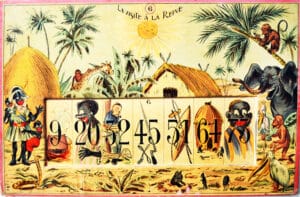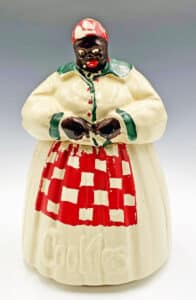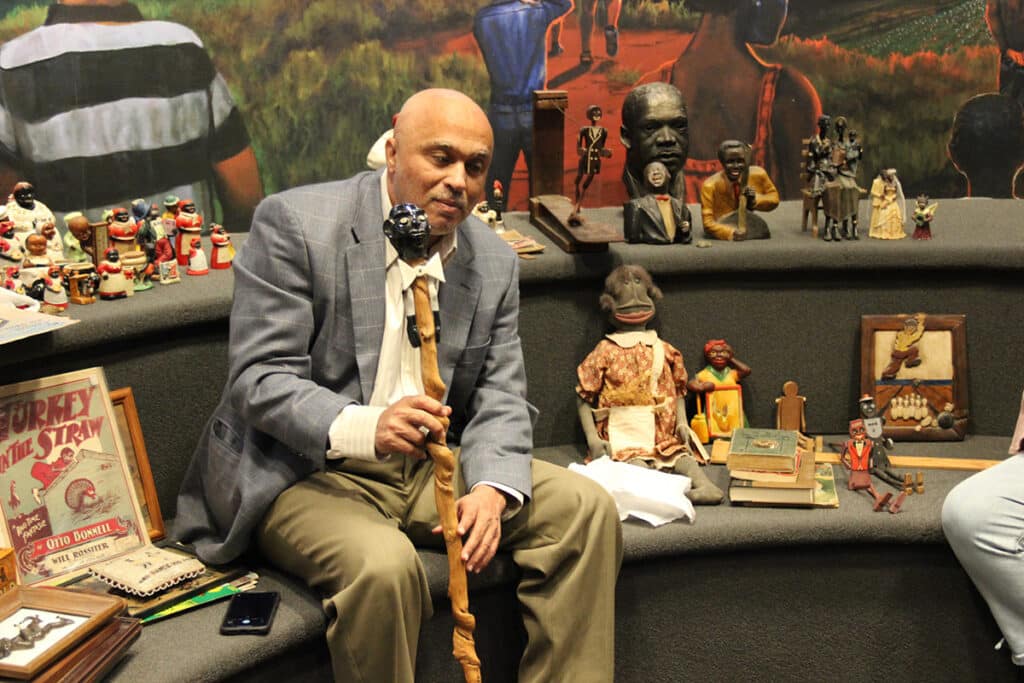By Maxine Carter-Lome, publisher
When we use the word “Americana” to identify an item associated with the culture and history of America, we are often referring to objects of historical rather than cultural significance; however, if the last decade of cultural and social awakening has taught us anything, it’s that Americana comes in many forms and colors.

One of the more controversial groups of Americana collectibles is Black Americana, also referred to as Black Memorabilia, Afro-Americana, and Black Face Collectibles; phrases used to describe memorabilia or ephemera that relates to African American history. Most of this material was produced from the 18th through the 20th centuries and ranged from pieces with very negative depictions of the cruelty of slavery to those that are more wholesome like the well-known Aunt Jemima, whose matronly and jovial nature was replicated on many pieces from cookie canisters to spice sets, dish towels, tea tins, etc. during the 1930s through the ‘50s.
The most common forms of Black Americana include such items as Black Face Mechanical Banks, Cookie Jars, Boot Scrapes, Ceramic Novelties, Folk Art, Pickaninny Dolls, Illustrations & Prints, Advertising, and Children’s Books depicting negative connotations and stereotypes that today are seen as cruel and insensitive; however, not all Black Americana collections have a negative connotation nor are they amassed due to bigotry. In fact, it is estimated that nearly half of all collectors are African Americans themselves who value the historical and cultural significance of these items, and believe they are worth preserving.
The derogatory nature of specific items, especially those mass-produced in the first half of the 20th century for commercial purposes, reflect a very different time in American history when it was acceptable to have black stereotypes not only in the home but everywhere. Yet, there are also many items of history that reflect uplifting aspects of African American culture, with collectors such as Oprah Winfrey, Whoopi Goldberg, and Spike Lee leading by example.
Collector Categories
As collectibles, Black Americana items typically fall into one of the following sub-categories:
Documents and artifacts that reflect the history of slavery: This is both an important and one of the most controversial collector categories for buyers and sellers of Black Americana. Some people feel very strongly that documents and items associated with slavery should never be sold or displayed for any reason while others contend their presence in the marketplace is a reminder of our history, however sorted and distasteful, and are important artifacts that therefore have intrinsic value. Such items include slave documents, broadsides, restraints, slave badges, etc.

Ephemera: This category can include letters, newspapers, books, autographs, prints, postcards, sheet music, and photographs, often featuring stereotypical caricatures and other offensive illustrations.
Advertising: Black Americans were often pictured in early advertising. Many of these representations are today deemed offensive but represent a period in our history of advertising. Such images can be found on tobacco tins, foodstuffs, soaps, sewing items, toys, and just about any marketable product.
Home Décor: Stereotypical images of African Americans were also depicted in home décor items such as ashtrays, wall plaques, ceramic novelties, cookie jars, salt and pepper shakers, cast iron banks, etc.
African American Heroes and Leaders: This category encompasses items from African American military heroes to abolitionists and noted figures in African American history.
Sports Heroes: Items associated with African American sports heroes, athletes, pioneers, and the Negro leagues are always a popular collector category (awards/medals, trading cards, autographs, sports equipment, uniforms, etc.), as is collecting memorabilia relating to African American Entertainers (letters, photographs, postcards, costumes, awards, First Day Covers, etc.).
The Ethics of Selling Black Americana
Many in the antiques trade question the ethics of placing a value on, making money from, or collecting items that reflect such a painful and shameful part of our history. While these items represent a historical record of our past and therefore have an intrinsic value, they can also be seen as highly offensive and hurtful, creating an ethical and moral dilemma for both buyers and sellers in today’s marketplace, and a debate as to what can and should be bought, sold, and collected.![In the throes of the Rodney King riots in 1992, Nehemiah Cisneros’ family store for Black collectibles in Inglewood was razed. Black illustrated books and Golliwog dolls salvaged from the ashes wound up on the shelves and in the closets of Cisneros’ childhood bedroom, ambivalent and uncanny reminders of both violence and resistance. “As the lifeless doll eyes of racially exploitative faces stared back at me while [I was] trying to fall asleep, I formed an atypical relationship with trauma; trauma became my guardian angel,” the artist said. photo: Control Gallery in Los Angeles](https://journalofantiques.com/wp-content/uploads/2024/10/Artist-Nehemiah-Cisneros-with-his-Golliwog-dolls-300x200.jpg)
internal debate with myself of whether it’s really ‘right’ to profit off of those items at all. Should I just donate them? Throw away? Try to sell locally? What would you do?”
Here are a few of the responses this inquiry received:
“I’m a museum collections management specialist … Please don’t destroy them. They can be used by museums or historic sites to teach about history (in this case the mistakes of history). If there is some local or regional origin of the memorabilia that you can find, I’m sure there’s a local or regional museum to go along with it that would want them, if not, the Jim Crow Museum, or even the Smithsonian might be interested if they’re super rare.”
“They are history, no matter how vile. Do not destroy them, please. Especially if they are coming up as fairly unique. … Many prominent Black Americans have collections of Jim Crow era memorabilia, including Oprah and Whoopi Goldberg.”
“I deal with NAZI s*** from deceased relative cleanouts all the time and I always 100% make sure that it never gets to racists by contacting museums. I never flip that s***.”
“Whatever you do, don’t destroy them (or throw them away) it’s history. Destroying history is the root for fascism, history is history no matter how bad it gets.”
“As a flipper, you need to make money where you can, and if you throw it away you’re destroying things that do have a historical value. It’s in the past, and the actions of those taken onto others are still in the past.”
“This is so much a bigger conversation, and I feel it needs a broader scope to realize what might be considered correct vs. taboo in American culture.”
In all, the thread generated 138 responses, reflecting the marketplace dilemma today for items of this nature.
![1200 Dollars Reward Illustrated broadside seeking runaways, including Allen Davidson and Sylla. Easton, [MD], August 23, 1858. The broadside, illustrated with vignettes of both a man and a woman, offers a hefty $1,200 reward, or $200 per adult, for the return of seven self-emancipated formerly enslaved individuals: Allen Davidson (about 28), “Sylla, or Priscilla” (30 to 35) with an infant (about 6 or 8 months old), twin brothers Bob and Perry Davidson (20), Horace Davidson (18), Charles Davidson (15 or 16). A physical description is also listed for each. This broadside sold for $9,450 at Freeman’s | Hindman in 2023.](https://journalofantiques.com/wp-content/uploads/2024/10/1200-reward-hindman-auction-200x300.jpg)
broadside seeking runaways, including Allen Davidson and Sylla. Easton, [MD], August 23, 1858. The broadside, illustrated with vignettes of both a man and a woman, offers a hefty $1,200 reward, or $200 per adult, for the return of seven self-emancipated formerly enslaved individuals: Allen Davidson (about 28), “Sylla, or Priscilla” (30 to 35) with an infant (about 6 or 8 months old), twin brothers Bob and Perry Davidson (20), Horace Davidson (18), Charles Davidson (15 or 16). A physical description is also listed for each. This broadside sold for $9,450 at Freeman’s | Hindman in 2023.
Black Americana on eBay
While collecting Black Americana does not sit comfortably with a lot of collectors, those that do collect find it difficult to look for new finds in their usual haunts as shops and shows remove items deemed offensive from their shelves and the marketplace.
eBay, one of the most popular spots for buyers and sellers of almost anything, does not allow for the sale of Black Americana it deems “offensive,” although what that looks like seems to be, like pornography, subjective in nature based on their community board.
eBay’s Offensive Materials policy refers to “Listings or content that promote or glorify hatred, violence, or discrimination.” That includes, among other things, “Black Americana items that are discriminatory,” and “Items with racist, anti-Semitic, or otherwise demeaning portrayals, for example through caricatures or other exaggerated features, including figurines, cartoons, housewares, historical advertisements, and golliwogs.”
A recent eBay seller questioned this policy in a post: “I placed a lot of 2 miniature cloth black Americana dolls (grandpa and grandma) on eBay and after they were sold I received a notice from eBay that my listing was removed as per their offensive material policy.” However, comments following the thread question why eBay has a Black Americana category in the first place if they do not allow for the sale of such items. Posted one respondent to answer that question, “The category exists to list Black Americana which is not offensive.” Quipped another, “So they can more easily find offenders.” Posted yet another on this active thread, “… no rhyme or reason. It was probably flagged because someone found the items offensive and submitted a report.”
Black Americana at Auction
While shops, shows, eBay, and flea markets are restricting the sale of Black Americana items, prestigious auction houses are diving headfirst into the market with specific Black Americana auctions that show strong demand and escalating values.
In February 2021, Cowan’s Auctions hosted its first various owner African Americana sale that brought 278 lots of storied artifacts to the block during Black History Month. Photography, books, ephemera, carvings, and artifacts – all culled from eras and categories that included famous Black business owners, the Civil Rights Movement, slavery and abolition, militaria including artifacts from the Buffalo Soldiers, and literary works from famous Black writers like Langston Hughes and Alain Locke. Leading the auction was an archive relating to the life of abolitionist George H. Hoyt (1837-1877), including material and testimonials gathered during his work as defense lawyer for abolitionist John Brown (1800-1859) in his famed 1859 trial, which sold for $43,750.
In 2022, Elizabeth Meaders, a 90-year-old retired teacher, auctioned off her personal collection of 20,000 artifacts documenting Black history for $1.5 million to a single buyer through Guernsey’s Auction House, keeping the collection intact. The assortment of pictures, posters, signs, statues, and memorabilia, amassed over seven decades, tell a comprehensive history of the Black American experience. Some of the highlights include an FBI wanted poster for Black Panther activist Angela Davis and the 1920s death mask of Jamaican-born Black nationalist Marcus Garvey.
In 2023, Freeman’s/Hindman held an African Americana 333-lot auction that covered pioneering figures and key moments from enslavement, abolition, and war, to politics, civil rights, literature, music, and the visual arts. Highlights include the first edition of Phyllis Wheatley’s Poems on Various Subjects, Religious and Moral (1773), the first book of poetry published by an African American; photographs and a letter signed by Frederick Douglass; imprints, and ephemera involving Dr. Martin Luther King, Jr., and most notably a first printing of Stride Toward Freedom: The Montgomery Story signed and inscribed by Dr. King; and a “Free Huey” flag flown at a protest demonstration to free Huey Newton near the Alameda County Courthouse, Oakland, CA, 1968.

In March 2024, Swann Galleries held an auction in New York City that included important documentation of the abolition movement, catalogs, and posters for exhibits by leading Black artists, previously unseen Black Panther material, material on Black-owned businesses, and more. The sale was led by The Negro Travelers’ Green Book, the vital travel guide for Black families from the late 1950s in the United States when a long-distance drive would be a cause for apprehension about finding lodging, gasoline, or even a restroom. The 80-page guide, which lists of Black-friendly service stations, hotels, nightclubs, and restaurants, sold for $35,000 (inclusive of buyer’s premium).
Despite the success of these and other recent auctions, the debate about the ethics of buying, selling, and collecting Black Americana rages on as dealers and collectors wrestle with this part of American history and what these items say about who we were and are today as a country.

![In the throes of the Rodney King riots in 1992, Nehemiah Cisneros’ family store for Black collectibles in Inglewood was razed. Black illustrated books and Golliwog dolls salvaged from the ashes wound up on the shelves and in the closets of Cisneros’ childhood bedroom, ambivalent and uncanny reminders of both violence and resistance. “As the lifeless doll eyes of racially exploitative faces stared back at me while [I was] trying to fall asleep, I formed an atypical relationship with trauma; trauma became my guardian angel,” the artist said. photo: Control Gallery in Los Angeles](https://journalofantiques.com/wp-content/uploads/2024/10/Artist-Nehemiah-Cisneros-with-his-Golliwog-dolls-1024x683.jpg)




Related posts: